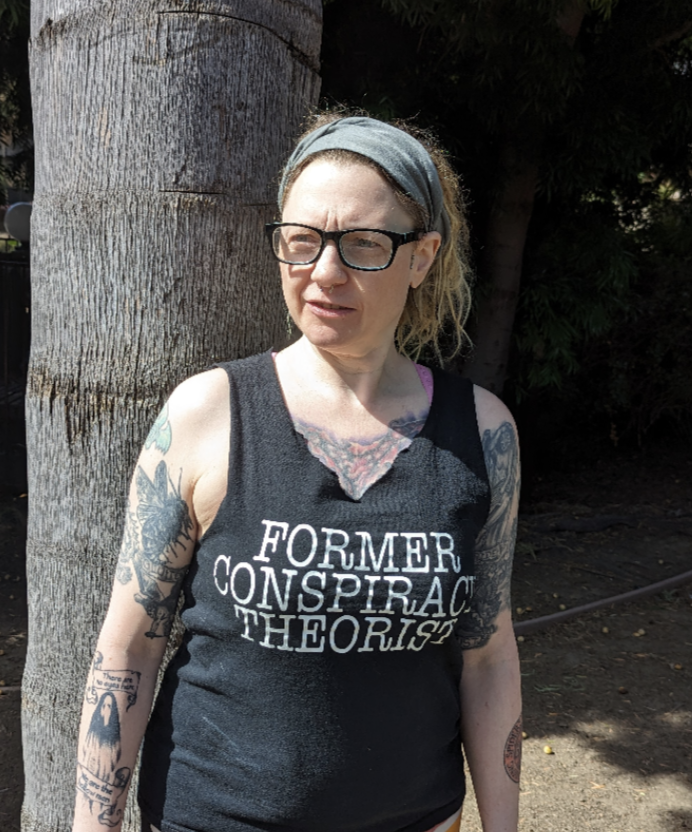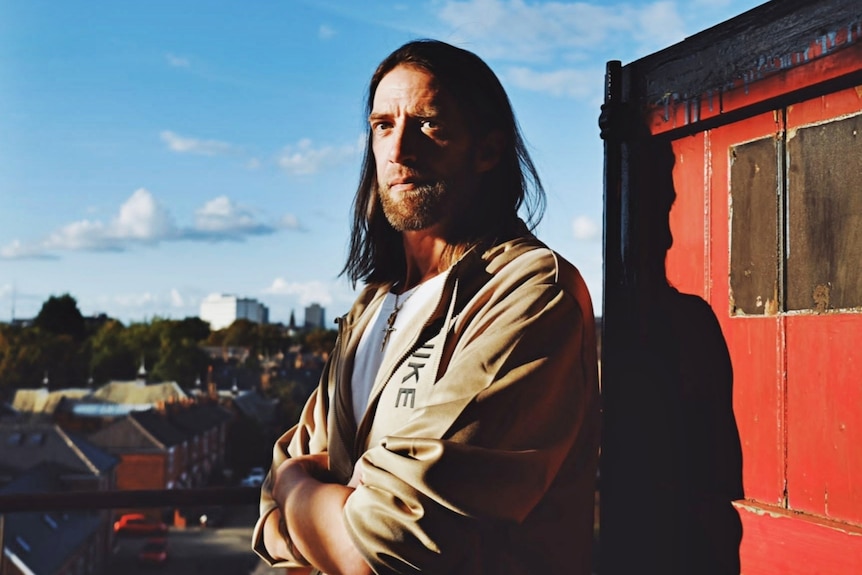These people were deep conspiracy theory believers for years. Then came an earth-shattering moment
There’s a moment Stephanie Kemmerer regrets so deeply that her voice cracks as she recalls it, though it happened 10 years ago.
She was chatting with a homeless woman outside a local shop about the 2001 terrorist attacks in the US.
The woman shared that a friend of hers had been on one of the planes that crashed into the Twin Towers.
“I looked right in her eyes and I said, ‘There were no planes’,” Stephanie says, drawing breath.
“I don’t know who this woman is, but if I could ever … I mean, there’s no way that I’d ever find her. But if I could, I would apologise. I would fall on my knees. That is just the coldest, cruellest thing I’ve ever done.
“But you can’t apologise to everyone.”
In her darkest place, the US-based Stephanie falsely believed the Twin Towers were destroyed by government design, and that the hijacked planes were edited into video footage.
She also falsely believed that the 2012 Sandy Hook Elementary School massacre, in which 20 children and six adults were murdered, was staged as part of a government plot to take away Americans’ guns — and that the children’s grieving parents were “crisis actors”.
(She’s thankful she was never one of the many conspiracy theorists who have harassed, and who continue to attack, those parents.)
Today Stephanie is, in her words, a conspiracy theorist in recovery.

And she wants to help others who are trapped in a world of false beliefs to recover, too.
“Conspiracy theories, they’re just a Bandaid over a broken bone … If you can solve the internal issue, then the conspiracy theories could theoretically just fall away,” she says.
How Stephanie fell down the rabbit hole
As a young child Stephanie was intensely interested in mysteries: lost cities, UFOs, Bigfoot, Spring-heeled Jack and other “weird stuff”.
She draws a direct line from those early interests to her belief in various conspiracy theories later in life.
“Looking back, I realise that those [mysteries] are soft entry points,” she says.
But there were other factors that made her vulnerable to disinformation as an adult.
In 2004, she had moved away from her friendship networks to live in a new city. Her mother had just died and she’d recently separated from her husband.
Plus, for the first time in her life, she had access to high-speed internet.
It wasn’t long before it had taken her to some very dark places.
She likens her descent into a conspiracy rabbit hole to drug addiction.
“I felt this rush of dopamine. I was feeling special, I was feeling warm and fuzzy,” she says.
There was a thrill in believing she knew something others didn’t; in having a mystery’s solution at arm’s reach. She found herself chasing the feeling more and more.
“The conspiracy theories were working for me just like [drugs do for] a heroin addict or a meth addict. You need a bigger and bigger dose as you form your tolerance. And I remember actively looking [and thinking], ‘What’s the next conspiracy I can get into?'”
A heartbreaking realisation
Like Stephanie, UK-based Brent Lee is also a former conspiracy theorist.

For 15 years he was a hardcore believer of conspiracies, including that “a network of secret societies and cults were actually controlling events around the world”.
“[I believed] terror attacks or mass shootings were done ritualistically and there were some sort of magic ceremonies to put a black magic spell on the populace so that we couldn’t see through the facade,” he tells ABC RN’s All in the Mind.
He also believed that September 11 was “an inside job perpetuated by the Bush administration and certain intelligence agencies”.
Brent says it was comforting to blame the US government for the attacks — rather than believing the biggest military in the world at the time and the largest intelligence network could have missed so many signs.
“You just don’t want to believe that that could happen because these people are the ones that are supposed to take care of you. And if they let that slip, to me that was unfathomable — so they must have done it instead,” he says.
Brent, co-host of podcast Some Dare Call it Conspiracy, which deconstructs popular conspiracy theories, walked away from it all in 2018.
Cracks in his beliefs had started to appear a few years earlier, around the time of the Sandy Hook massacre.
The conspiracy theory that everyone involved in it was a crisis actor “didn’t gel” with his own conspiracy beliefs.
“I had been thinking that these [mass casualty events] were rituals; these were sacrifices. So now when everyone’s saying that [these murders] didn’t actually happen, well, what’s the point in getting angry about this? Like, if no one died, why do I care?” he says.
It was a turning point, and the start of Brent pulling away from the conspiracy theory community.
“That was really important because that meant I didn’t need to comply with what the rest of the community was saying, so I was able to be a little bit more isolated from everyone else’s control,” he says.
It was a confusing time. He decided to give himself space, and logged off Facebook to “figure it all out”.
“What I found was that there’s so much more counter-information today than there was when I first fell down the rabbit hole, even about conspiracy theories, [like] where did they come from and why do we believe them — and that’s what really helped pull me out completely,” he says.
He felt heartbroken, and not only at the realisation that “everything I thought was going on was actually not going on”.
“But also that I didn’t do any of the things that normal adults do, because I thought the New World Order was coming to get me. There’s no need to chase a career, get a mortgage or have kids or any of this kind of thing.
“That’s what I feel like I lost most.”
Listening to the doubts
“Doubt is the way out,” Stephanie says.
Around 2016, she began experiencing a niggling urge whenever she sat at her keyboard.
“I heard this little voice in my head every time I went to YouTube and I typed in ‘9/11 conspiracies’. I kept hearing this tiny voice yelling at me: ‘Type “debunk”. Put in “9/11 conspiracy debunk” — put that in’.”
She now knows that voice was the sign that she was ready for a change.
So in early 2017, when a very close, trusted friend said they knew, and had worked with, one of the Sandy Hook parents, it was a bombshell moment.
“I felt my whole life, everything inside of me, just crumble and shatter,” Stephanie says.
Instantly, she asked herself why this friend would lie, and could only conclude that they wouldn’t.
The following day she finally typed “debunk” into her browser and it was “another shattering moment”. She was confronted with true stories about Sandy Hook and September 11.
“I said [to myself], ‘I don’t want to be like this anymore’.”
She thought: “I’m so sick of this. I hate myself. I hate my life. I hate everyone else. This is exhausting.”
Escaping and healing
Stephanie was determined to put her knowledge of the conspiracy theory movement to good use.
Today, she helps others through her support group, DOUBT (Discussing Our Unusual Beliefs Together).
She has also contacted Leonard Pozner, the father of the youngest victim of the Sandy Hook shootings, six-year-old Noah, whose non-profit, HONR Network, helps protect vulnerable people from online abuse, including from conspiracy theorists.
“I told him my story and … we talked for like two hours and I got to tell him at the end, I’m sorry for the loss of Noah and I’m sorry that I used to think it was fake. And he said thank you,” she says.
“So I actually did get to apologise to someone that I indirectly hurt and … it’s been healing.”
How to bring someone back from conspiracy theories
Since his recovery from conspiracy beliefs, Brent has rebuilt his life.
“Everything that I’ve gone through made me who I am today. I’m incredibly proud of myself having the courage to actually question my own beliefs, question what I’ve been told,” he says/
“I’m happy. I’ve got my podcast, I’m helping people. I’m explaining what this [conspiracy] world was like, what this mindset was like, and it’s helping a lot of people.”
He says the best thing anyone can do who’s lost someone they love to conspiracies is to keep talking, keep the relationship going.
“So if they ever do stop believing, they know they have supports around.
“If you can remind them that, hey, I’m not trying to have an argument with you. We love each other, we respect each other, we’ve known each other all our lives. Let’s try and figure this out together. Because maybe you’ve got some answers that I don’t have. And maybe I’ve got some that you don’t have.
“Don’t give up hope. Because if I can do it, as far down as I was, almost anyone can.”
RN in your inbox
Get more stories that go beyond the news cycle with our weekly newsletter.
Posted 14h ago14 hours agoTue 11 Jun 2024 at 9:00pm, updated 13h ago13 hours agoTue 11 Jun 2024 at 10:50pm


